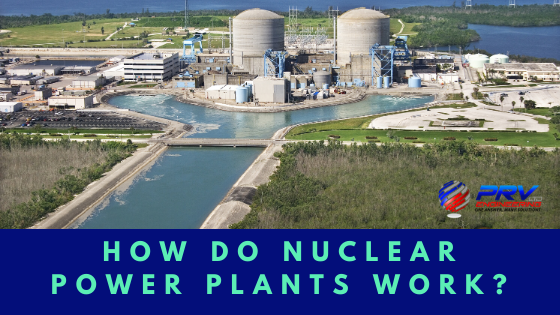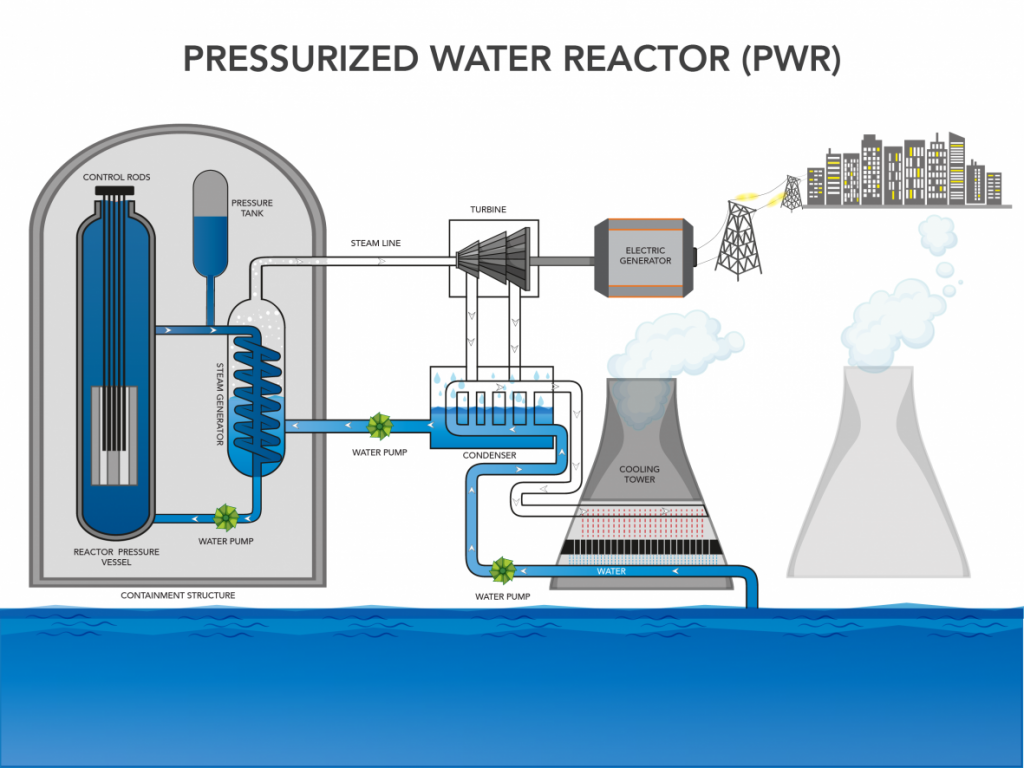
There are two types of nuclear reactions which can generate energy, i.e. nuclear fission and nuclear fusion. But what are the differences and how does it all work? In this article, we take a look at nuclear power plants, the different types and some of the pros and cons of nuclear energy.
What’s The Difference Between Nuclear Fission And Nuclear Fusion?
Many believe that nuclear fission and nuclear fusion are used in nuclear power plants but we only use nuclear fission. Strange though as we know that nuclear fusion is actually a better alternative in terms of availability and energy production. In addition, nuclear fission is also more polluting and hazardous to work with.
Nuclear fission is the process of generating heat by splitting heavy atoms with high-speed particles, usually neutrons. On the other side, nuclear fusion is the process of generating heat by joining two lightweight atoms to form a heavier atom. In fact, the sun works on nuclear fusion and while it’s better than nuclear fission, replicating the process is difficult and tiring.
How Does It Work In Nuclear Power Plants?
Modern nuclear generators use nuclear fission to generate heat and these reactors use ceramic Uranium Oxide pellets for its cores. These Uranium atoms are split by bombarding it with neutrons, resulting in a tremendous amount of heat which releases more neutrons.
The newly formed neutrons then hit other Uranium atoms which just keep generating more heat and neutrons. This process is known as a chain reaction and nuclear power plants control the rate by using moderators like graphite or water.
Essentially, a coolant absorbs the heat and prevents the reactor from overheating which is not a good thing when using Uranium. This heat turns the coolant to steam and from there, it becomes a useful energy source.
Components Of Nuclear Power Plants
While components and the setup can vary depending on the type of nuclear reactor, the primary components are usually as follows:
- Nuclear fuel (Uranium or Plutonium)
- Nuclear reactor and moderator (graphite or water)
- Reactor coolant (typically water)
- Control rods made from graphite
- Shield or containment system/structure
- Pressure vessel
- Steam generator, steam lines and a steam turbine
- Pumps
- Cooling tower and condenser
Types Of Nuclear Power Plants
More than 65% of commercial nuclear reactors in America are Pressurised Water Reactors (PWR).

Boiling Water Reactors (BWR) account for about one-third of all reactors in America. In fact, Fukushima was also Boiling Water Reactor.

In Canada and India, Pressurised Heavy Water Reactors (PHWR) are most common while the UK mainly uses Advanced Gas-Cooled Reactor (AGR). These are so-called “second-generation gas-cooled reactors” which use carbon dioxide as the main coolant.
Light Water Graphite-Moderated Reactors (RBMK) are Soviet designs and while similar to BWRs, each fuel assembly has an individual pipe allowing the coolant (water) to flow around the fuel. Did you know that Chernobyl was an RBMK nuclear reactor?
Advanced reactors include many new or experimental types, like small modular reactors (SMR). Fast neutron reactors (FNR) use fast neutrons which are more efficient for energy production but more expensive to build.
Why Don’t We Use Nuclear Fusion Instead?
At the moment, there are around 450 commercial nuclear fission reactors globally. Many believe it is one of the safest and most efficient energy sources in the world. However, the future should be nuclear fusion but it’s easier said than done.
As mentioned earlier, the process to recreate the heat required for the reaction is extremely arduous. This is mainly due to the temperature and pressure at the sun’s core being much greater than what nuclear reactors can recreate.
If we were to replicate the process, the reactor temperature must reach up to 6 times the temperature at the sun’s core. As you can imagine, this is incredibly high and equates to about 100 million degrees Celsius. As the sun’s core sustains the high pressure, it can facilitate fusion with only 15 million degrees Celsius.
The Future Of Nuclear Fusion
Scientists have been trying to figure out how to create a fusion reaction on earth for some time. The first attempt was made through an apparatus called Tokamak, a doughnut-shaped chamber. It uses electricity to charge gas within the tube which changes the state to Plasma.
Since the chamber is a vacuum before pumping in the gas, the scientists could mimic the high pressure and raise the temperature to sustain a fusion reaction. However, this reaction requires loads of electricity and a chamber that can hold the plasma without melting any of the parts.
The good news is that 35 nations have collaborated on creating cleaner, safer energy. Combined, they pooled resources of $25 billion to create the largest research project in history, ITER or International Thermonuclear Experimental Reactor.
Interesting Facts
Last year, researchers at the Princeton Plasma Physics Laboratory successfully stabilised plasma in fusion reactors. There are also many start-up companies that want fusion energy operational before 2035. One example is Commonwealth Fusion Systems, a company that aims to have a working fusion reactor as early as 2025.
The thermal output of Uranium pellets in nuclear reactors are immensely powerful and economical in a way. Did you know that only 20 grams of Uranium can make as much energy as 400 kg of coal? To give an indication of a real-life scenario; eight Uranium pellets can provide power to a house for an entire year.
Comparing nuclear energy with other fossil fuels in terms of producing heat, nuclear energy is much cleaner since it doesn’t produce any CO2.
Interesting article: ‘Is Solar Power All It Cracks Up To Be?’
Conclusion On Nuclear Power Plants
While nuclear power plants have long been imagined as the answer to nearly unlimited energy, it has lost some of the earlier appeal. One of the main reasons is due to a misunderstanding of the technology as it’s often associated with nuclear weapons.
Then there is the risk of accidents and even though we’ve only seen very few when nuclear power plants go wrong, the fallout can be devastating. It is arguably one of the safest ways to generate energy and we must remember that these accidents were caused by human error, natural disasters or design flaws.
The technology is one of the most highly regulated, environmentally-friendly and safety conscious. Considering the rise in climate change concerns, we need to have an open and fair debate around the use of nuclear power plants. The way things are, nuclear power could very well be part of the solution.
Want More From PRV Engineering?
If you liked reading this article, please share your thoughts in the comment section below and join the conversation on social media using the hashtag, #PRVtech. You can also follow our blog for all the latest on manufacturing, engineering and technology.
PRV Engineering specialises in precision engineering and custom fabrication covering a wide range of industries. Among others, we work within Automotive, Aerospace, Defence, Oil and Gas, Railway and Construction. Get in touch if you have any questions about PRV Engineering or how we can help with your engineering project.
This site uses Akismet to reduce spam. Learn how your comment data is processed.


 Mail:
Mail: 




Leave a Comments